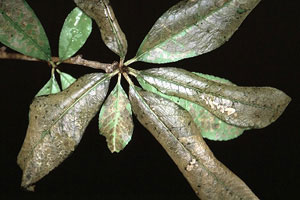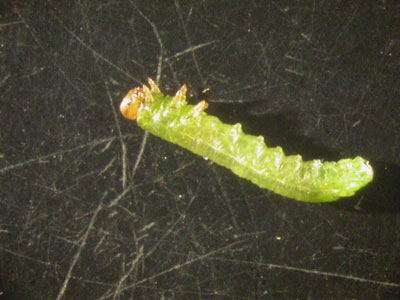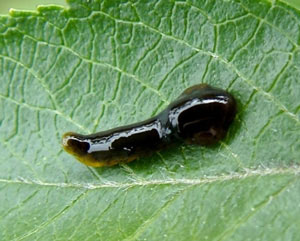Pear Sawfly
HOSTS
- Buttonbrush
- Cherry
- Cotoneaster
- Juneberry
- Mountain ash
- Pear
- Plum
- Quince
DESCRIPTION
The pear sawfly (Caliroa cerasi), which is actually a wasp, is a common pest on pear, cherry, and hawthorn in Utah. The slug-like appearance of the larval stage has prompted this insect to also be referred to as the pear or cherry slug in various parts of the country. On fruit trees which are treated for other pests, the pear sawfly is rarely a problem, but in untreated situations the entire tree may be defoliated.
BIOLOGY
Adults have four wings, are black and yellow and slightly larger than a common house fly.
The early instar (a developmental stage) larvae are grey-green, lack distinct legs and are wide at the front end of the body. They secrete a slime which completely covers the earlier instars, resulting in a slug-like appearance. The last instar larvae is green-orange, caterpillar-like, and has distinct legs.
SYMPTOMS
- Skeletonized leaves.
- Dead leaves.
GENERAL MANAGEMENT
Chemical Control:
Proper spray timing occurs when larvae are visible during either generation. Active ingredients (AI’s) that are effective for control of pear sawfly include (numbers and letters following AI’s indicate their chemical group): carbaryl (1A), esfenvalerate (3A), insecticidal soap (ungrouped), spinosad A&D (5). Some commercial products contain the AI’s cyfluthrin (3A), lambda-cyhalothrin (3A), and spinosad A&B (5). Chemical groups repersent insecticides that have a similar mode of action (MoA). Rotate products from differnet groups every year to minimize insect resistance to insecticides. Make sure the product you select is recommended for your intended application site, e.g., ornamental or fruit trees.
Non-Chemical Control:
As mentioned previously, the pear sawfly is rarely a problem if any pesticides are used for control of other insects. In certain circumstances, however, the pear sawfly can reach damaging population levels. Because the larvae are extremely susceptible to dessication, several references indicate that road dust, wood ashes, or dirt thrown on the tree is enough to control this insect. Removing larvae from leaves by hand and placing them in a bucket containing soapy water, or spraying the foliage with a strong stream of water are also effective strategies.





